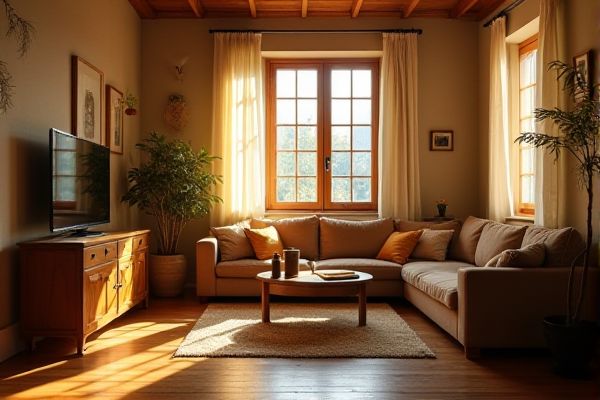
Warm light creates a cozy and inviting atmosphere with its yellow and amber tones, ideal for relaxing spaces like living rooms and bedrooms. Understanding the differences between warm light and cool light can help you choose the perfect lighting for your home, so read on to discover which suits your needs best.
Table of Comparison
| Feature | Warm Light | Cool Light |
|---|---|---|
| Color Temperature | 2700K - 3500K | 5000K - 6500K |
| Appearance | Soft, yellowish glow | Bright, bluish-white |
| Best For | Living rooms, bedrooms, restaurants | Offices, hospitals, task lighting |
| Effect on Mood | Calming, cozy, relaxing | Energetic, alert, focused |
| Energy Efficiency | Similar efficiency; depends on bulb type | Similar efficiency; depends on bulb type |
| Eye Comfort | Gentle on eyes, reduces strain in low light | May cause eye fatigue if too bright or prolonged exposure |
Understanding Warm and Cool Light
Warm light emits a yellowish or amber hue, creating a cozy and inviting atmosphere, while cool light produces a bluish or white tone that enhances alertness and clarity. Understanding warm and cool light helps you choose the right illumination for different spaces, such as warm light for relaxing areas and cool light for workspaces. The color temperature measured in Kelvins (K) ranges from 2700K (warm) to 5000K and above (cool), guiding your lighting decisions.
The Science Behind Light Color Temperature
Light color temperature, measured in Kelvin (K), quantifies the warmth or coolness of light emitted by a source, with warm light ranging from 2700K to 3000K and cool light from 5000K to 6500K. Warm light mimics the natural hues of sunrise and sunset, promoting relaxation and comfort by stimulating melatonin production, while cool light resembles daylight, enhancing alertness and concentration through higher blue light content. Understanding the physiological and psychological effects of these temperatures is crucial for optimizing lighting design in environments such as homes, workplaces, and healthcare facilities.
Visual Differences: Warm vs Cool Light
Warm light features a yellow to amber hue, creating a cozy and inviting atmosphere that enhances reds and oranges in the environment. Cool light emits a blue to white tone, promoting alertness and clarity while accentuating blues and greens. These visual differences influence mood and perception, making warm light ideal for relaxation and cool light suitable for tasks requiring focus.
Psychological Effects of Warm and Cool Light
Warm light, characterized by its yellowish tones and color temperatures between 2700K and 3000K, promotes relaxation and comfort by stimulating the production of melatonin, which helps regulate sleep cycles and reduce stress. Cool light, with color temperatures ranging from 5000K to 6500K, enhances alertness and cognitive function by suppressing melatonin release, making it ideal for workspaces and areas requiring focus. Exposure to warm light in evening hours supports circadian rhythm alignment, while cool light during daytime optimizes productivity and mood by mimicking natural daylight.
Best Applications for Warm Light
Warm light creates a cozy and inviting atmosphere, making it ideal for living rooms, bedrooms, and dining areas where relaxation and comfort are priorities. Its lower color temperature, typically between 2700K and 3000K, enhances warm tones and softens shadows, perfect for settings that benefit from a soothing ambiance. Your best applications for warm light include spaces designed for winding down, entertaining, and fostering intimate conversations.
Ideal Uses for Cool Light
Cool light is ideal for workspaces, offices, and kitchens where clear visibility and focus are essential. It enhances concentration by mimicking natural daylight, making it suitable for reading, studying, and detailed tasks. Cool light also reduces eye strain and creates a crisp, energizing atmosphere conducive to productivity.
Energy Efficiency: Warm vs Cool Lighting
Warm light typically consumes slightly more energy than cool light due to its lower luminous efficacy, but the difference is minimal with modern LED technology. Cool light bulbs often provide higher lumens per watt, making them more energy-efficient in scenarios requiring bright, task-oriented lighting. Selecting the right light temperature for Your space can optimize energy use while enhancing comfort and functionality.
Impact on Interior Design and Ambience
Warm light enhances interior design by creating a cozy, inviting atmosphere that highlights warm color palettes and natural textures. Cool light promotes a clean, modern aesthetic, emphasizing crisp lines and vibrant colors while improving visibility and focus. Your choice between warm and cool lighting directly influences the mood and functionality of your living space.
Choosing the Right Light for Every Room
Warm light with a color temperature around 2700K to 3000K creates a cozy and relaxing atmosphere, making it ideal for living rooms and bedrooms where comfort is key. Cool light, ranging from 4000K to 5000K, enhances focus and clarity, making it suitable for workspaces, kitchens, and bathrooms that require bright, crisp illumination. Selecting the appropriate light temperature according to room function improves ambiance, productivity, and overall comfort.
Tips for Mixing Warm and Cool Light
Mixing warm and cool light effectively requires balancing color temperatures to create a visually appealing atmosphere, typically combining warm light around 2700K-3000K with cool light in the 4000K-5000K range. Use warm light for cozy, intimate areas such as living rooms or bedrooms, while cool light suits task-oriented spaces like kitchens or offices. Experiment with dimmers and layered lighting to achieve harmonious contrast without harsh transitions, enhancing both comfort and functionality.
 homyna.com
homyna.com